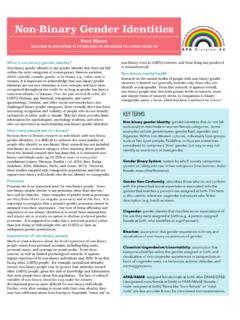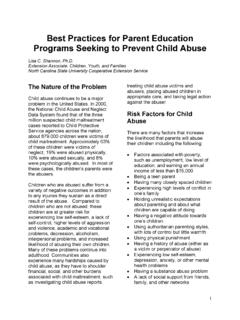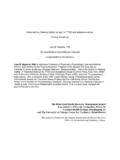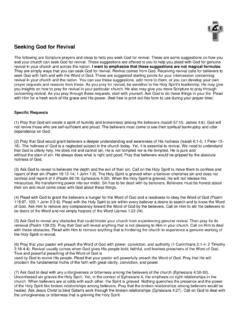Transcription of BC Psychologist 15 - APA Divisions
1 BC Psychologist 15 Psychogenic polydipsia (Exessive Fluid seeking Behaviour)d o n a l d d o n hutcheon, , c. psychol.( u k) . , r . p s y c h . The Vice-President of the BC Psychological polydipsia is, on a continuum, the compulsion to seek out and over drink any/all fluids and is a type of polydipsia exhibited by patients with mental illness and/or the developmentally disabled. It is also present in a subset of schizophrenics. These individuals, often chronic schizophrenics with a long history of mental illness, frequently exhibit enlarged ventricles and shrunken cortex on MRI, making the physiological mechanism difficult to isolate from the psychogenic.
2 Psychogenic polydipsia is a serious disorder that often leads to institutionalization as it can be very difficult to manage outside the inpatient setting. It should be taken very seriously and can be life-threatening, as serum sodium is diluted to an extent that seizures and cardiac arrest can occur. Those individuals afflicted have been known to seek fluids from any source possible. The clinical presentation is as follows: the client drinks large amounts of any/all fluids, which raises the pressure of the extracellular medium. As a side effect, the antidiuretic hormone level is lowered.
3 The urine produced by these clients will have a low electrolyte concentration, and it will be produced in large quantities ( , polyuria). If the individual is institutionalized, close monitoring by staff is necessary to control fluid intake. In extreme episodes, the client s kidneys will be unable to deal with fluid overload and weight gain will be noted (Gibson, WikiDoc Resources, 2010). polydipsia is increased thirst and excessive fluid intake, greater than 3L per day. As many as 20% of schizophrenics are polydipsic Pand approximately 3 .5% 5% of all schizophrenic clients develop a more serious symptom of self-induced water intoxication ( , SIWI).
4 Individuals diagnosed with psychogenic polydipsia of which 80% are diagnosed with schizophrenia have a fluid intake that is usually 4 10L/day, some drink up to 22L/day! Hyponatremia is a low serum sodium level below 130mmol/L (normal range 135 1 45 mmol/L). Polyuria is urine output in excess of 3L/day. In the psychiatric population, polyuria exists as a compensatory mechanism for polydipsia ; 25% of polydipsia patients have acute development of hyponatremia where there is a precipitous drop in serum sodium. This occurs sporadically and unpredictably and results in the syndrome of water intoxication ( , SIWI).
5 Clozapine is an atypical antipsychotic medication, which, in low doses, is the most common pharmacological intervention in the treatment of self-induced water intoxication ( , SIWI). The restriction of fluid intake appears to have little or no influence on the excessive urge to drink by clients diagnosed with psychogenic polydipsia . As a result, investigators have turned to pharmacological interventions to treat either the polydipsia itself or the hyponatremia. Of note: clozapine has well-known side effects, including orthostatic hypotension, lowering of seizure threshold, anti-cholinergic toxicity, and significant incidence of agranulocytosis (1% 2%).
6 Many clients with polydipsia or hyponatremia may have multiple physical illnesses that could preclude the use of clozapine (Verghese, deLeon & Josiassen, 1996). Behavioural strategies include limiting the daily water intake when indicated, initiating fluid restriction when there is a significant weight increase, taking a serum sodium levels count if signs and symptoms of intoxication start to appear, providing constant attention for the patient which can include locking the individual in seclusion for their own safety. Behavioral management programs should be mandatory. Psychosocial rehabilitation (PSR) programs for individuals diagnosed with psychogenic polydipsia , requiring tertiary care, should be guided by the principles of psychosocial rehabilitation, with sophisticated medication management and behavioural interventions.
7 The PSR approach to service delivery is based upon fundamental and interconnected concepts (Canadian Code of Ethics, PSR, 2010):16 Spring programs emphasize the need for individually tailored interventions;PSR programs emphasize a flexibility, either the individual s capacities be adapted to environmental realities or the environment be changed to suit the capacities of the person;PSR programs are oriented to exploitation of people s strengths;PSR programs aim at the restoration of hope;PSR programs emphasize the vocational potential of mentally ill individuals;PSR programs extend beyond work activities to encompass a full array of social and recreational life concerns;Recipients of PSR programs are actively involved in their own care;The PSR program is an ongoing Care RequirementsTertiary care is generally provided to persons with severe and persistent mental illness (SPMI).
8 These clients exhibit conditions and problem behaviours that require services well above those provided with the secondary care level (Wasylenki, Goering, Cochrane, Simon & Wirth-Couchon, 2000). This enriched type of treatment should require referral from secondary care for those individuals with problems that are complex and refractory to primary and secondary care. Criteria for success usually includes the need for higher levels of management and security, staff expertise, and staffing program resources, all in conjunction with more detailed and specialized assessment and treatment. During the past 10 years, psychiatric service delivery research and expert opinion has successfully promoted community-based services providing tertiary care, to reduce reliance on traditional hospital-based tertiary care (Wasylenki et al, 2000).
9 In contrast to past reliance on traditional inpatient settings for tertiary care, it is possible to employ flexible strategies to maximize time in the least restrictive settings. Level of staff expertise is a critical element of tertiary care. Tertiary care providers have generally advanced training and a commitment to service the population of clients with psychogenic polydipsia . Many long-term residents diagnosed with psychogenic polydipsia who reside in a provincial or state psychiatric hospital, can graduate from inpatient tertiary care services to a community resource, if the funding allows for an appropriate staffing model.
10 More specifically, hospital patients who have complex but stable conditions can be supported in community settings with access to tertiary services Hutcheon, 2012). In sum, excessive fluid drinking may occur in almost any psychiatric disorder ( , Histrionic Personality Disorder). However, most cases (about 80%) of psychogenic polydipsia with self-induced water intoxication, occur with clients with a psychotic illness, usually of the schizophrenic type. The prevalence of compulsive water drinking in state psychiatric hospitals in the United States has been estimated between 7% 18% (Jose & Perez-Cruet, 1979), and about half of this population suffer from the complications of SIWI (Hariprasad, Eisinger & Naider, 1988).


















